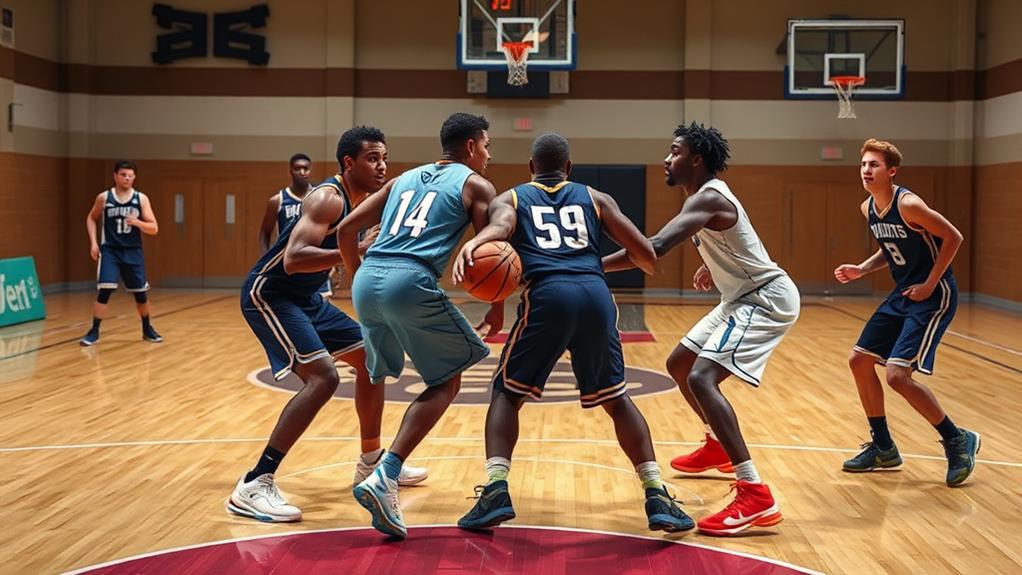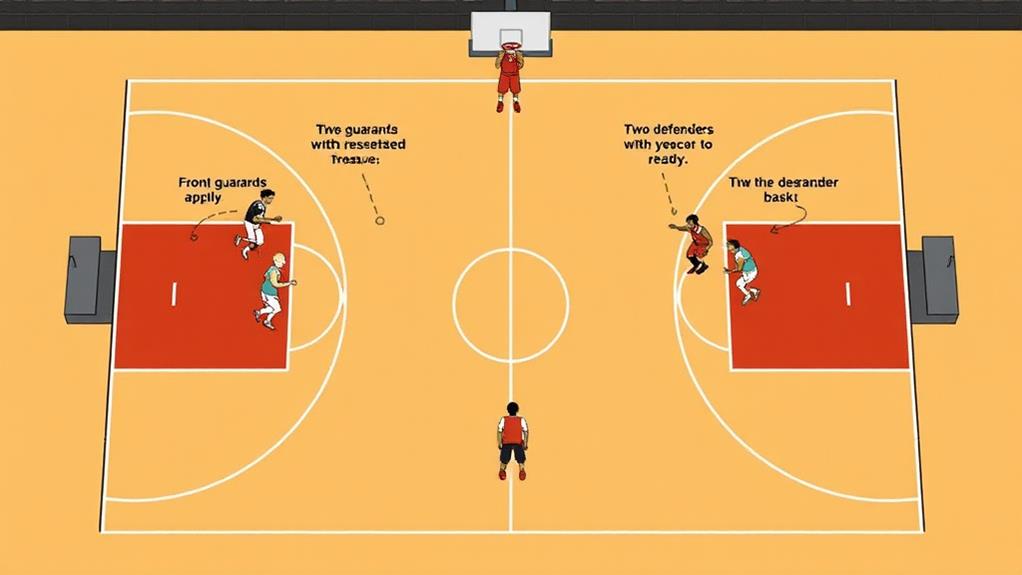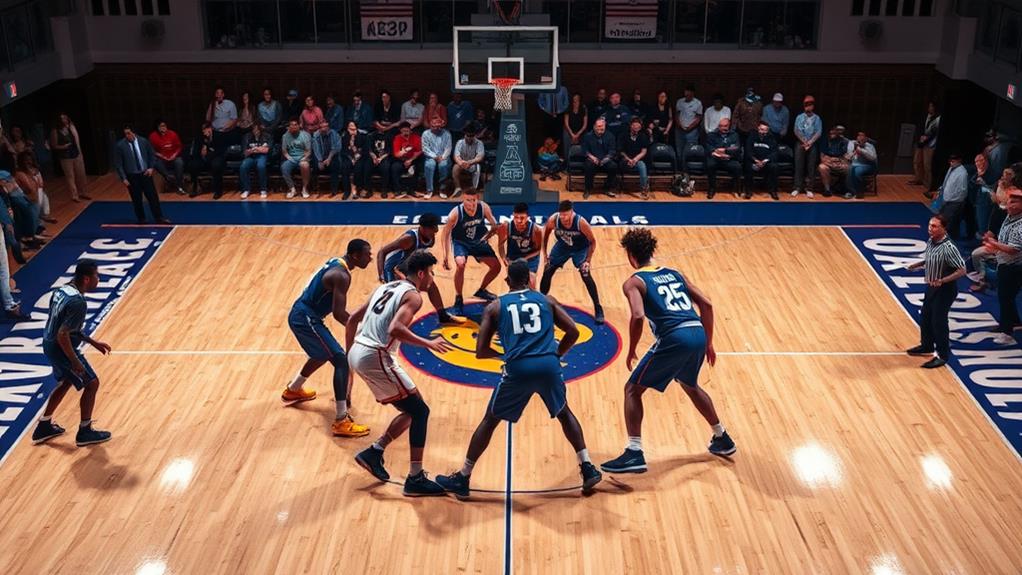
Breaking Down the 2-2-1 Press Defense in Basketball
September 27, 2024The 2-2-1 press defense is all about disrupting your opponent's rhythm. In this setup, two guards pressure the ball handler while two forwards cover the half-court. Your center plays a key role in guarding the basket. The goal is to force the ball toward the sidelines, creating traps and opportunities for interceptions. You've got to maintain constant communication and adapt quickly as situations change. While this defense can lead to turnovers, it also requires high stamina and coordination to succeed. There's much more to uncover about its strategies and effectiveness that can elevate your game.
Goal and Advantages
The 2-2-1 press defense aims to disrupt your opponent's offense by limiting their options and controlling the pace of the game. The primary goal is to keep the ball away from the middle, forcing play along the sidelines. This creates opportunities for traps and interceptions, effectively tightening your grip on the game.
The evolution of defensive strategies has led to more sophisticated implementations of pressing defenses like the 2-2-1, as teams adapt to counteract high-efficiency shooting and varied offensive styles.
One of the key advantages of this pressure defense is its ability to disrupt the opponent's tempo. By applying consistent pressure, you compel them to play at an uncomfortable pace, leading to rushed decisions and mistakes. As the shot clock runs down, their offensive options dwindle, increasing the likelihood of turnovers.
Teamwork is essential in executing the 2-2-1 press. Effective trapping and coverage require clear communication and coordination among defenders. Each player needs to understand their role, ensuring they maintain pressure while anticipating the opponent's moves.
Moreover, this style of defense can physically and mentally exhaust the opposing team. The sustained pressure not only increases the chances of forcing mistakes but also heightens the likelihood of capitalizing on those turnovers, ultimately giving your team a competitive edge.
Rules and Setup
In the 2-2-1 press defense, players align strategically to create a formidable barrier against the offense. You'll find two guards (X1, X2) positioned at the high post elbows, while two forwards (X3, X4) stand near the half-court line. The center (X5) occupies the high post area.
A critical rule of this setup is to prevent any middle penetration by the offensive team, forcing the ball-handler towards the sidelines where traps can be executed. This approach aligns with modern defensive strategies that emphasize adaptability and perimeter defense, as teams increasingly face high-efficiency shooters and three-point offenses historical shifts in defensive approaches.
Positioning is essential in this defensive strategy. Defenders must maintain pressure, especially during traps, without committing fouls. When younger players participate, all defenders need to retreat to the key before matching up with their assignments, ensuring defensive integrity from the start.
This setup not only discourages easy layups but also encourages outside shots, compelling the offensive team to move the ball strategically.
Roles and Responsibilities

Understanding the roles and responsibilities within the 2-2-1 press defense is vital for its success. Each defender has a specific function, and when executed correctly, you can effectively pressure the offensive team and create turnovers.
Utilizing data-driven strategies can enhance the effectiveness of your defensive schemes by optimizing player positioning and fostering team chemistry.
- Front Line Defenders (X1, X2): These players pressure the ball handler, funneling them toward the sideline. They maintain a distance that forces the offensive player into making slower decisions, allowing for better trapping opportunities.
- Middle Line Players (X3, X4): One player focuses on executing traps, aiming to force lob passes, while the other protects the basket. Their coordination is essential to anticipating offensive movements and creating chances to intercept the ball.
- Back Line Defender (X5): This player reads the developing plays and communicates with teammates. You'll need to intercept passes and maintain awareness of both the ball and player movements from this position.
Strategies for Execution
Executing the 2-2-1 press defense requires a blend of strategic positioning and quick decision-making. As defenders, you need to force the ball-handler toward the sideline. The closest guard should apply pressure, while the weak-side front line player slides to deny middle passes, ensuring effective trapping opportunities.
Modern defenses, similar to how centers influence both offensive and defensive outcomes, benefit from adaptable strategies that keep the offense guessing.
For successful trap execution, strong communication is vital between the on-ball defender and the strong-side second-line player as the offensive player approaches the second line. This synergy sets up the first trap, creating a chaotic environment for the ball-handler. Anticipation of passing lanes is essential; back line defenders must stay aware of both ball and player movement to maximize interception chances during traps.
When the ball reverses, return to your original 2-2-1 positions. Position front line players at high posts to disrupt the offensive team's vision and redirect play toward the sidelines.
Lastly, be ready to adapt to offensive strategies. Constantly adjust your defensive positioning to cover gaps and prevent easy passing lanes that could exploit your press defense. This proactive approach enhances your team's chances of forcing turnovers and controlling the game tempo.
Effectiveness and Challenges

The 2-2-1 press defense can really shake up an opponent's rhythm, forcing them into quick decisions that often lead to turnovers. By applying pressure, you create chaotic situations that challenge the offensive players to make hasty passes. This strategy requires excellent player conduct and teamwork to guarantee all players are on the same page.
However, there are effectiveness and challenges to take into account:
- Stamina Requirements: This press demands high energy from your players. If they get fatigued, it's tough to maintain pressure effectively throughout the game.
- Exploitation of Gaps: Skilled offensive teams can exploit any gaps in your press. If defenders aren't positioned well or communication breaks down, you risk allowing easy scoring opportunities.
- Need for Constant Adjustments: You'll need to adapt your strategy based on the opponent's reactions. Failing to make necessary adjustments can lead to significant scoring runs against your team.
As a coach, balancing the effectiveness of the 2-2-1 press with these challenges is essential.
Conclusion
To sum up, the 2-2-1 press defense can be a game-changer when executed correctly. By understanding its rules and roles, you can keep opponents on their toes and create turnovers. Remember, teamwork is the name of the game; everyone's got to be on the same page. While it has its challenges, when you hit the ground running, you'll see how effective this strategy can be in turning the tide of a match.


